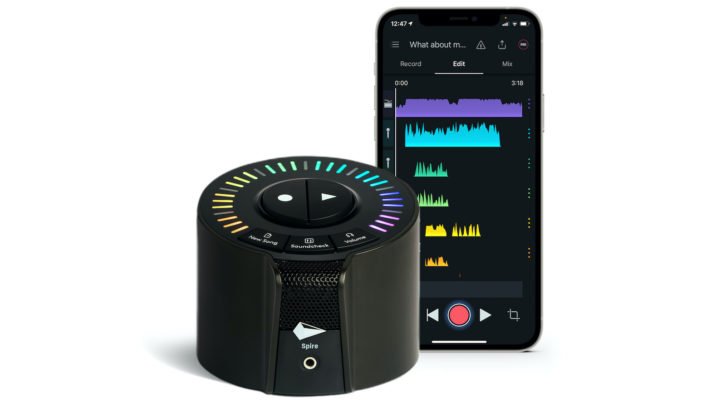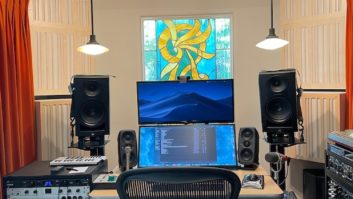 Spire Studio disproves the cliché “You can’t take it with you.” Based around a small, sort-of-cylindrical hardware unit that runs on AC or batteries (up to four hours on a charge), and a free iOS or Android app, it’s a portable system that gives you multitrack recording, a quality built-in omni mic, two combo inputs, phantom power, a headphone jack, effects and more.
Spire Studio disproves the cliché “You can’t take it with you.” Based around a small, sort-of-cylindrical hardware unit that runs on AC or batteries (up to four hours on a charge), and a free iOS or Android app, it’s a portable system that gives you multitrack recording, a quality built-in omni mic, two combo inputs, phantom power, a headphone jack, effects and more.
iZotope released the original Spire Studio hardware in 2017 and recently started shipping 2nd Generation. In addition to beefing up and streamlining the app, iZotope added cloud-based storage, improved the preamps and doubled the onboard recording space.
You can record in the hardware without the app, or in the app without the hardware, but you get the best results when using them together. The app connects to Spire Studio through a Wi-Fi network created by the hardware. You can record up to eight tracks, with an Unlimited Tracks feature in beta and coming soon.
The built-in omni mic sounds clean and accurate. I tried it both with acoustic guitar and vocals and was impressed. iZotope built a nifty utility called Soundcheck into the hardware unit. You play or sing into the mic and Spire Studio guesses the source type. It then sets the input volume and applies a custom EQ curve.
The Mix screen uses iZotope’s unique Visual Mixer concept. It gives you a field where the vertical axis represents volume and the horizontal pan. Your tracks show up as icons that you move around the screen to create your mix. You can mute individual tracks but not solo them.
iZotope Updates, Relaunches Spire Studio
The only part of Spire Studio (2nd Generation) that I’m not crazy about is its effects workflow. You get a decent choice of recording effects, including bass and guitar amp sims, lots of vocal treatments and more, and most offer a selection of adjustable parameters. The problem for me is that you have to apply the effects on input, which prints them to the track. iZotope sees this as an advantage because users can hear the effects while recording. At the least, I’d prefer the option to revert to the dry track before mixing.
If you’re a subscription member, you also get mix effects including vocal tuning, but you have to disconnect from the hardware unit to access them. That means you can no longer monitor through the unit’s headphone jack and have to switch to your mobile device’s headphone output.
You can easily export your mix or individual tracks (as 24-bit/48kHz audio) to your computer for later import to your DAW. When you’re ready for the export, you get a button labeled Enhance, which applies an automatic mastering algorithm to the mix. Only one problem: you have to reconnect to the unit to access it.
Although it could be a useful tool for any recording musician, Spire Studio is clearly aimed at novices. As a result, its simplified workflow can be frustrating for anyone with studio experience. If you can live with those limitations, it offers a good-quality portable recording system in a compact package.







